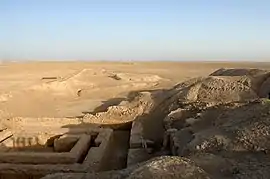Architecture of Iraq
The architecture of Iraq encompasses the buildings of various architectural styles that exist in Iraq.
Mesopotamian
Islamic

Islamic architecture would flourish during the Umayyad, Abbasid, and Ottoman periods.
Abbasid
In the mid 8th century, the Round city of Baghdad was founded as the Abbasid capital, following the Abbasid victory over the Umayyad calpihate. While the Umayyads had typically reused pre-Islamic buildings in the cities they had conquered, by the Abbasid era many of these structures required replacement.
Ottoman
The Al-Wazeer Mosque, Al-Maqam Mosque, are examples of Ottoman architecture in Iraq.
Modern
Kingdom of Iraq
In the 1950s, as Iraq became wealthier due to oil revenue during the reign of King Faisal II, several important projects were commissioned. Numerous foreign architects, including Walter Groupius and Le Corbusier were invited to Iraq to design various public buildings during this period.[3] Among these was American architect Frank Lloyd Wright, who drew up the Plan for Greater Baghdad, which would include a cultural center, opera house, and university on the outskirts of Baghdad.[3] However, it was never built due to the collapse of the monarchy in 1958.
Post 1958
During his tenure as President, Saddam Hussein oversaw the construction of several monuments and palaces, including the Victory Arch and al Faw Palace.[4] Many of these have been described as tacky, and unrepresentative of actual Iraqi architectural tradition.[5][6]
References
- "The Ahwar of Southern Iraq: Refuge of Biodiversity and the Relict Landscape of the Mesopotamian Cities". UNESCO. Retrieved 2021-01-30.
- "Samarra Archaeological City". UNESCO. Retrieved 2021-01-30.
- "CNN.com - Frank Lloyd Wright's plans for greater Baghdad - Sep. 29, 2003". edition.cnn.com. Retrieved 2021-01-30.
- "Saddam Hussain's architectural heritage—and what to do with it". Archinect. Retrieved 2021-01-30.
- Donaldson-Evans, Catherine (2015-03-25). "Saddam's Palaces Are Tasteless and Tacky". Fox News. Retrieved 2021-01-30.
- "Architecture After Excess: The Palaces of Saddam's Baghdad". Failed Architecture. Failed Architecture. Retrieved 2021-01-29.
Bibilography
- Al-Janabi, Tariq Jawad (1982). Studies In Mediaeval Iraqi Architecture. Baghdad: Republic of Iraq. Iraq: Ministry of Culture and Information State Organization of Antiquities and Heritage.CS1 maint: ref=harv (link)
- Le Strange, Guy (1900). Baghdad during the Abbasid Caliphate from contemporary Arabic and Persian Sources.
